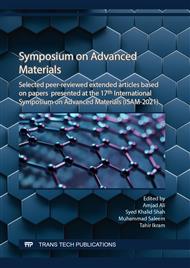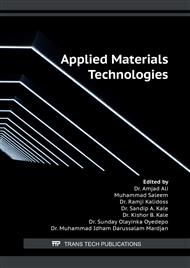p.139
p.145
p.153
p.163
p.177
p.183
p.191
p.199
p.207
Optimizing the Morphology, Structure and Optoelectronic Properties of Aluminum Doped Zinc Oxide Thin Films Developed via Wet Chemical Synthesis
Abstract:
Transparent conducting oxides (TCOs) are wide band gap semiconductors having found their use in optoelectronics, flexible electronics, flat panel displays, electrochromic windows, transparent heater windows, and many more. Aluminum (Al) doped zinc oxide (AZO) is an important TCO material which is being widely investigated for such applications. Its optoelectronic properties can be tuned by adjusting the Al content. In this work we study the variation patterns of the electrical conductivity and the optical transparency of AZO thin films with altering the Al content between 0 and 8 at%. The AZO thin films were prepared by wet chemical synthesis from its stabilized sol of zinc acetate dihydrate and aluminum nitrate nonahydrate dissolved in an ethanol and methanol mix. The morphological, electrical, and optical characteristics of these films were explored employing optical microscopy, Hall effect measurements, and UV-Vis-NIR spectrophotometry, respectively. We found out that annealing induces cracks into the AZO thin films and can severely degrade its electrical conductivity. Therefore, it’s imperative to control the Al content as well as the film morphology and structure. Before studying the effects of the Al content, the cracks were mitigated by optimizing the deposition and annealing conditions. The films were spin coated from its sol at 3000 RPM for 30 seconds. The films were dried at 100 °C and were subsequently annealed at 450°C. Since annealing induced cracks, therefore three coats were applied and annealed each time to mitigate the number of transverse cracks across the thickness of the film. The crack minimization was also confirmed by the enhancement in electrical conductivity. For the uniform crack-free AZO films, the Al doping was found to significantly modify the electronic behavior of the films. We expect an initial increase in the conductivity up to around 2 at% Al doping beyond which a decrease in conductivity is expected due to Al2O3 formation.
Info:
Periodical:
Pages:
183-189
Citation:
Online since:
August 2022
Authors:
Price:
Сopyright:
© 2022 Trans Tech Publications Ltd. All Rights Reserved
Share:
Citation:



